Should Entrepreneurs be Concerned with Triple Bottom Line?
VerifiedAdded on 2023/06/05
|14
|4327
|130
AI Summary
This report analyzes whether entrepreneurs need to be concerned with the triple bottom line (TBL) and the challenges they face in adhering to it. It covers a literature review on the topic, theoretical frameworks to understand social entrepreneurship, and specific challenges while operating in complex, dynamic, and uncertain business environments. The report concludes that entrepreneurs must adopt a mission to satisfy the profit, the planet, and the people to be successful.
Contribute Materials
Your contribution can guide someone’s learning journey. Share your
documents today.

Running head: ENTREPRENEURIAL BUSINESS AND PLANNING
Should Entrepreneurs be Concerned with Triple Bottom Line?
Name of the student:
Name of the university:
Author note:
Should Entrepreneurs be Concerned with Triple Bottom Line?
Name of the student:
Name of the university:
Author note:
Secure Best Marks with AI Grader
Need help grading? Try our AI Grader for instant feedback on your assignments.
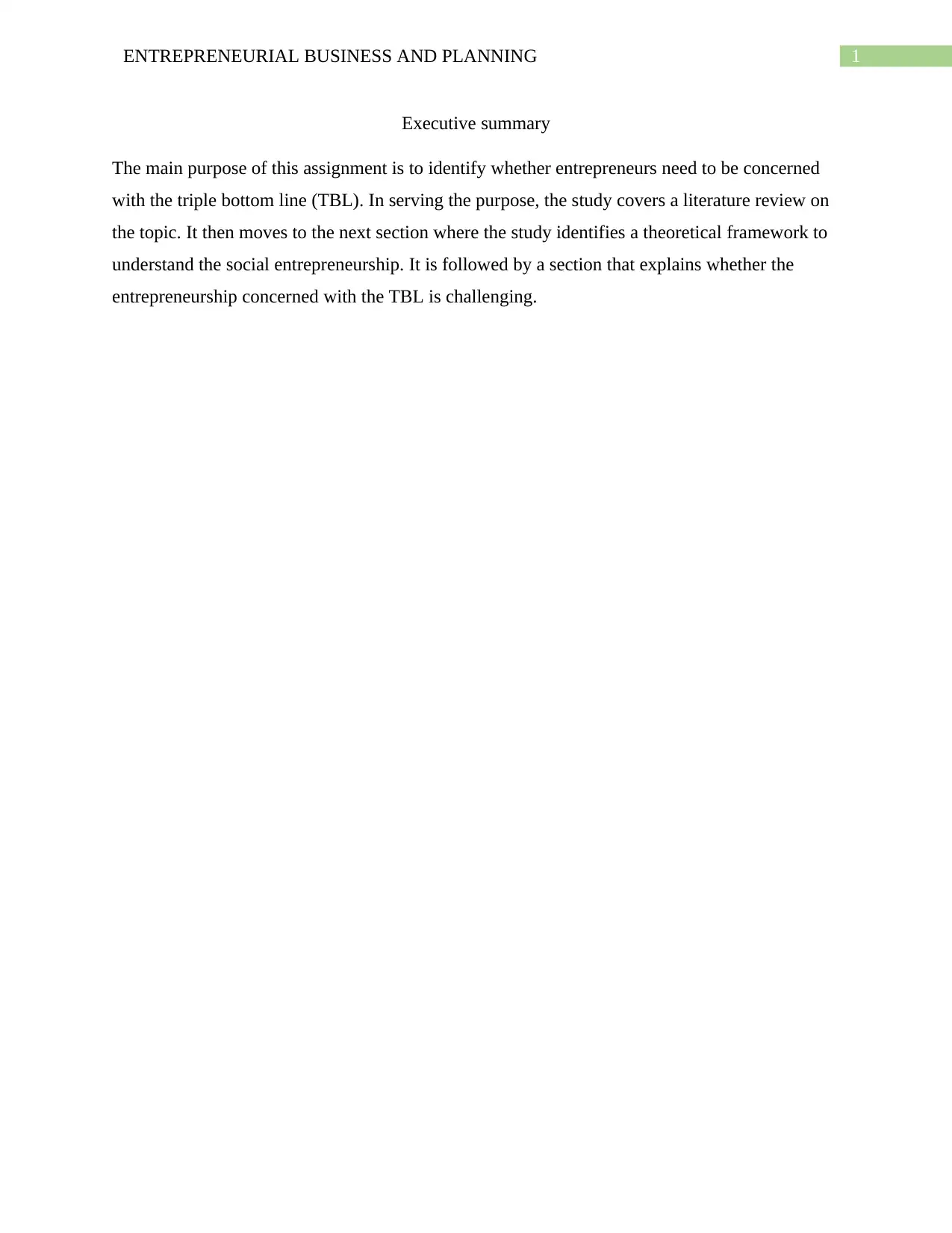
1ENTREPRENEURIAL BUSINESS AND PLANNING
Executive summary
The main purpose of this assignment is to identify whether entrepreneurs need to be concerned
with the triple bottom line (TBL). In serving the purpose, the study covers a literature review on
the topic. It then moves to the next section where the study identifies a theoretical framework to
understand the social entrepreneurship. It is followed by a section that explains whether the
entrepreneurship concerned with the TBL is challenging.
Executive summary
The main purpose of this assignment is to identify whether entrepreneurs need to be concerned
with the triple bottom line (TBL). In serving the purpose, the study covers a literature review on
the topic. It then moves to the next section where the study identifies a theoretical framework to
understand the social entrepreneurship. It is followed by a section that explains whether the
entrepreneurship concerned with the TBL is challenging.
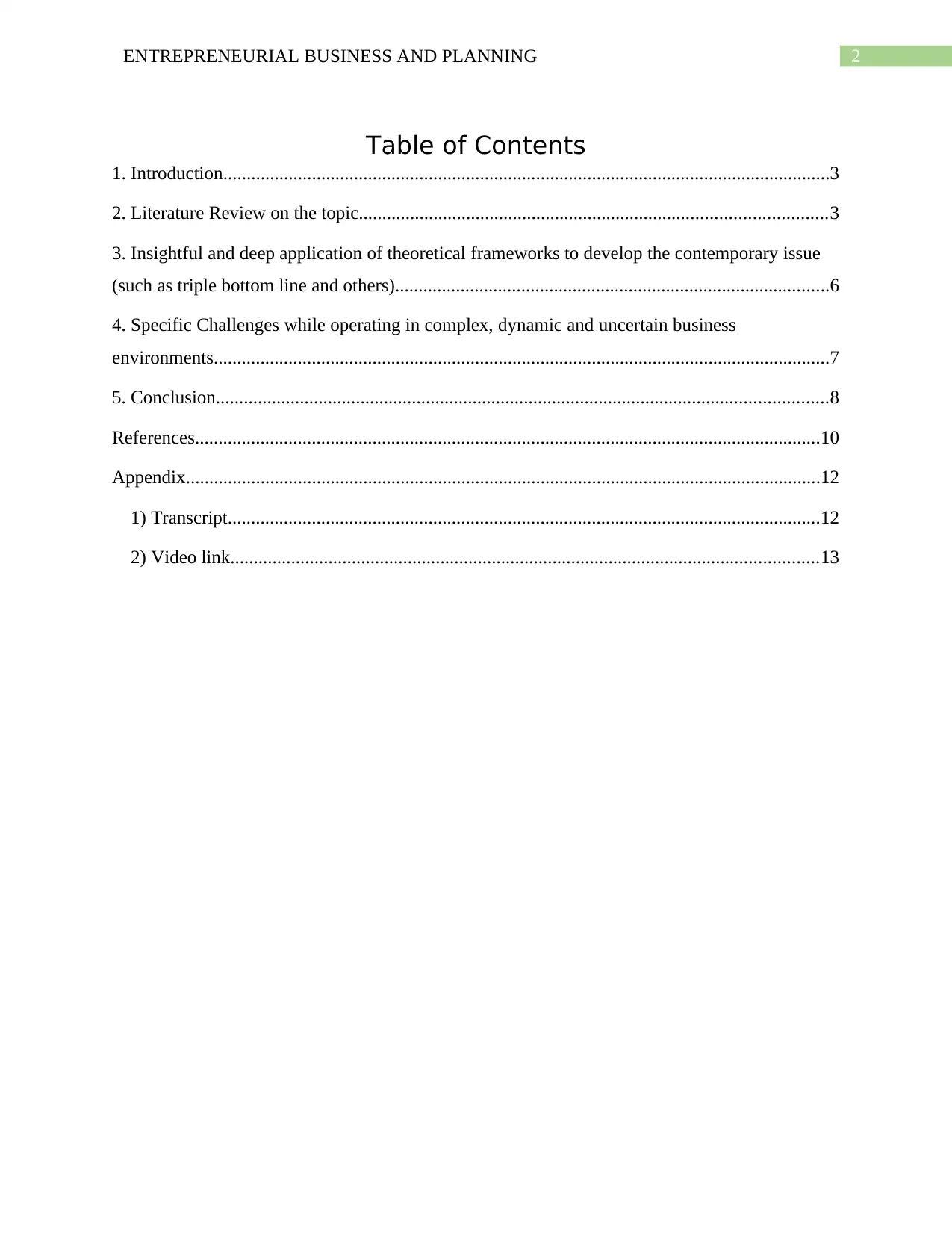
2ENTREPRENEURIAL BUSINESS AND PLANNING
Table of Contents
1. Introduction..................................................................................................................................3
2. Literature Review on the topic....................................................................................................3
3. Insightful and deep application of theoretical frameworks to develop the contemporary issue
(such as triple bottom line and others).............................................................................................6
4. Specific Challenges while operating in complex, dynamic and uncertain business
environments....................................................................................................................................7
5. Conclusion...................................................................................................................................8
References......................................................................................................................................10
Appendix........................................................................................................................................12
1) Transcript...............................................................................................................................12
2) Video link..............................................................................................................................13
Table of Contents
1. Introduction..................................................................................................................................3
2. Literature Review on the topic....................................................................................................3
3. Insightful and deep application of theoretical frameworks to develop the contemporary issue
(such as triple bottom line and others).............................................................................................6
4. Specific Challenges while operating in complex, dynamic and uncertain business
environments....................................................................................................................................7
5. Conclusion...................................................................................................................................8
References......................................................................................................................................10
Appendix........................................................................................................................................12
1) Transcript...............................................................................................................................12
2) Video link..............................................................................................................................13
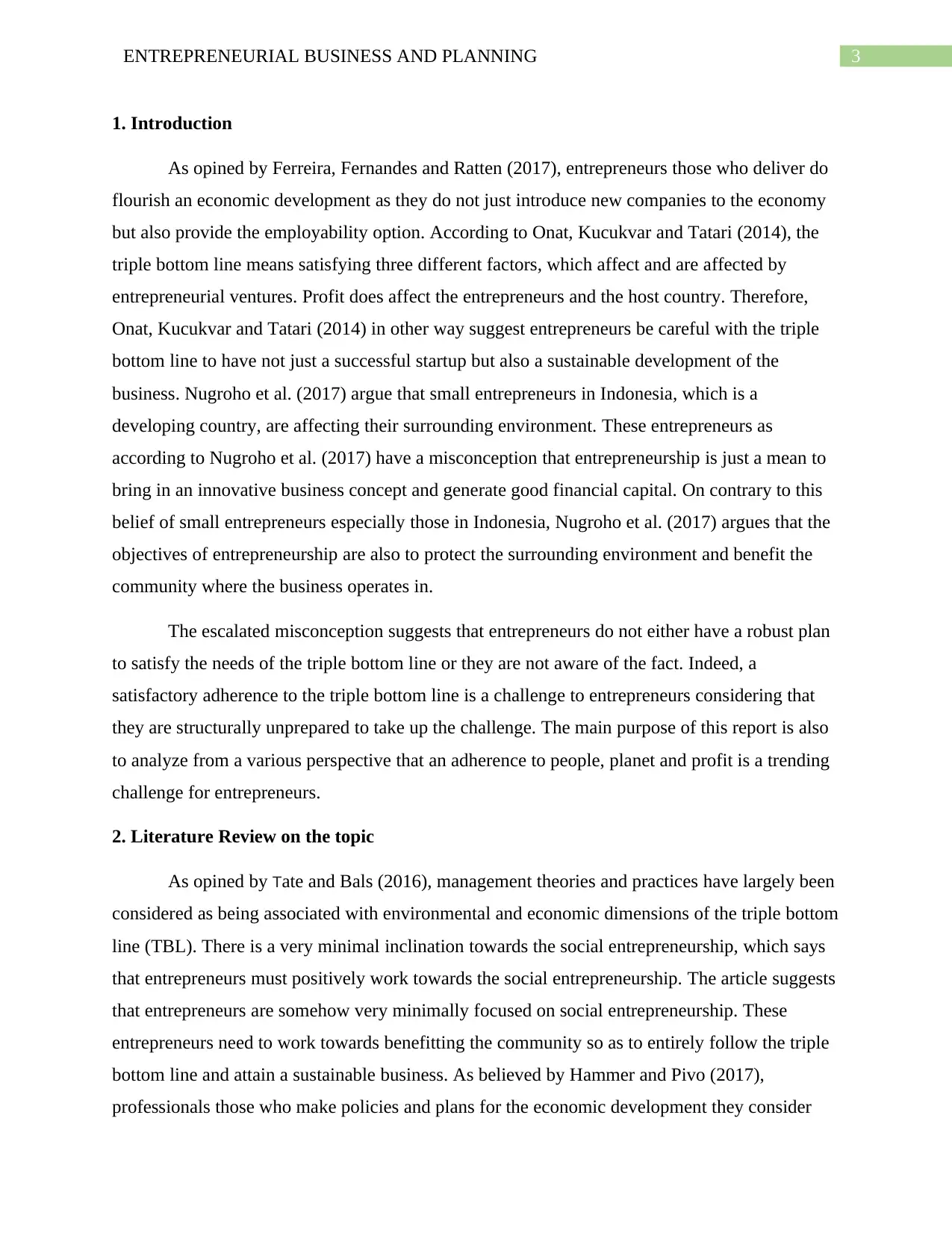
3ENTREPRENEURIAL BUSINESS AND PLANNING
1. Introduction
As opined by Ferreira, Fernandes and Ratten (2017), entrepreneurs those who deliver do
flourish an economic development as they do not just introduce new companies to the economy
but also provide the employability option. According to Onat, Kucukvar and Tatari (2014), the
triple bottom line means satisfying three different factors, which affect and are affected by
entrepreneurial ventures. Profit does affect the entrepreneurs and the host country. Therefore,
Onat, Kucukvar and Tatari (2014) in other way suggest entrepreneurs be careful with the triple
bottom line to have not just a successful startup but also a sustainable development of the
business. Nugroho et al. (2017) argue that small entrepreneurs in Indonesia, which is a
developing country, are affecting their surrounding environment. These entrepreneurs as
according to Nugroho et al. (2017) have a misconception that entrepreneurship is just a mean to
bring in an innovative business concept and generate good financial capital. On contrary to this
belief of small entrepreneurs especially those in Indonesia, Nugroho et al. (2017) argues that the
objectives of entrepreneurship are also to protect the surrounding environment and benefit the
community where the business operates in.
The escalated misconception suggests that entrepreneurs do not either have a robust plan
to satisfy the needs of the triple bottom line or they are not aware of the fact. Indeed, a
satisfactory adherence to the triple bottom line is a challenge to entrepreneurs considering that
they are structurally unprepared to take up the challenge. The main purpose of this report is also
to analyze from a various perspective that an adherence to people, planet and profit is a trending
challenge for entrepreneurs.
2. Literature Review on the topic
As opined by Tate and Bals (2016), management theories and practices have largely been
considered as being associated with environmental and economic dimensions of the triple bottom
line (TBL). There is a very minimal inclination towards the social entrepreneurship, which says
that entrepreneurs must positively work towards the social entrepreneurship. The article suggests
that entrepreneurs are somehow very minimally focused on social entrepreneurship. These
entrepreneurs need to work towards benefitting the community so as to entirely follow the triple
bottom line and attain a sustainable business. As believed by Hammer and Pivo (2017),
professionals those who make policies and plans for the economic development they consider
1. Introduction
As opined by Ferreira, Fernandes and Ratten (2017), entrepreneurs those who deliver do
flourish an economic development as they do not just introduce new companies to the economy
but also provide the employability option. According to Onat, Kucukvar and Tatari (2014), the
triple bottom line means satisfying three different factors, which affect and are affected by
entrepreneurial ventures. Profit does affect the entrepreneurs and the host country. Therefore,
Onat, Kucukvar and Tatari (2014) in other way suggest entrepreneurs be careful with the triple
bottom line to have not just a successful startup but also a sustainable development of the
business. Nugroho et al. (2017) argue that small entrepreneurs in Indonesia, which is a
developing country, are affecting their surrounding environment. These entrepreneurs as
according to Nugroho et al. (2017) have a misconception that entrepreneurship is just a mean to
bring in an innovative business concept and generate good financial capital. On contrary to this
belief of small entrepreneurs especially those in Indonesia, Nugroho et al. (2017) argues that the
objectives of entrepreneurship are also to protect the surrounding environment and benefit the
community where the business operates in.
The escalated misconception suggests that entrepreneurs do not either have a robust plan
to satisfy the needs of the triple bottom line or they are not aware of the fact. Indeed, a
satisfactory adherence to the triple bottom line is a challenge to entrepreneurs considering that
they are structurally unprepared to take up the challenge. The main purpose of this report is also
to analyze from a various perspective that an adherence to people, planet and profit is a trending
challenge for entrepreneurs.
2. Literature Review on the topic
As opined by Tate and Bals (2016), management theories and practices have largely been
considered as being associated with environmental and economic dimensions of the triple bottom
line (TBL). There is a very minimal inclination towards the social entrepreneurship, which says
that entrepreneurs must positively work towards the social entrepreneurship. The article suggests
that entrepreneurs are somehow very minimally focused on social entrepreneurship. These
entrepreneurs need to work towards benefitting the community so as to entirely follow the triple
bottom line and attain a sustainable business. As believed by Hammer and Pivo (2017),
professionals those who make policies and plans for the economic development they consider
Secure Best Marks with AI Grader
Need help grading? Try our AI Grader for instant feedback on your assignments.

4ENTREPRENEURIAL BUSINESS AND PLANNING
economic, social and environmental dimensions as integral to it, yet there are a very few who do
so. There is an evident gap between the TBL philosophy of entrepreneurs and their practices.
This can be due to a number of interrelated factors. First, economic development is practically
the point of attraction for entrepreneurs. They are less informed on and have limited supports to
look the other part of entrepreneurship, which is to fulfill its objectives of TBL. Second, the
environment where the economic developments happen is highly competitive and is also outside
the control of the jurisdiction. The success is also narrowly defined. At last, there may be a lack
of coordination and integration among several programs and policies and the actualization of
economic, social and environmental goals of entrepreneurship. This may affect the overall
outcome of an entrepreneurship, which is to attain economic development.
In the opinion of Soto-Acosta et al. (2016), the entrepreneurial attitude in Romania and in
developing nations is positive towards two factors of TBL, which are people and profit.
However, SMEs have largely faced issues with the social entrepreneurship. These SMEs are
ventured to produce the profits. SMEs are also involved in corporate social responsibility (CSR)
works, which they feel is all they are supposed to do to produce a positive impact on the
environment where the business operates in. However, CSR alone is not just sufficient to
produce a positive impact on the environment. As according to Chan and Cheung (2015), CSR is
just the set of programmes with possibly no positive intention towards the betterment of the
environment. It is possibly a kind of marketing activity, which is gaining popularity among the
SMEs and multinational companies nowadays. These all suggest that SME entrepreneurs in
developing nations and specifically in Romania are more focused on building up the financial
capital. They are either ignorant towards or they lack a firm governance towards fulfilling the
real objectives of TBL.
Ozanne et al. (2016) argue that organizational stakeholders feel them torn between giving
priorities to stakeholders and competing objectives. Organizations those that aim to adhere to the
triple bottom line principles, they are into ‘belonging tensions’, which means that they are
confused about the type of dimension of TBL they are largely aligned with and should give
priority to. The article clearly suggests that entrepreneurs though considered being aligned with
economic development, they are not sure of their approach and the ways to head to meet the
principles of TBL. According to Galpin and Hebard (2015), entrepreneurs do value and emphasis
economic, social and environmental dimensions as integral to it, yet there are a very few who do
so. There is an evident gap between the TBL philosophy of entrepreneurs and their practices.
This can be due to a number of interrelated factors. First, economic development is practically
the point of attraction for entrepreneurs. They are less informed on and have limited supports to
look the other part of entrepreneurship, which is to fulfill its objectives of TBL. Second, the
environment where the economic developments happen is highly competitive and is also outside
the control of the jurisdiction. The success is also narrowly defined. At last, there may be a lack
of coordination and integration among several programs and policies and the actualization of
economic, social and environmental goals of entrepreneurship. This may affect the overall
outcome of an entrepreneurship, which is to attain economic development.
In the opinion of Soto-Acosta et al. (2016), the entrepreneurial attitude in Romania and in
developing nations is positive towards two factors of TBL, which are people and profit.
However, SMEs have largely faced issues with the social entrepreneurship. These SMEs are
ventured to produce the profits. SMEs are also involved in corporate social responsibility (CSR)
works, which they feel is all they are supposed to do to produce a positive impact on the
environment where the business operates in. However, CSR alone is not just sufficient to
produce a positive impact on the environment. As according to Chan and Cheung (2015), CSR is
just the set of programmes with possibly no positive intention towards the betterment of the
environment. It is possibly a kind of marketing activity, which is gaining popularity among the
SMEs and multinational companies nowadays. These all suggest that SME entrepreneurs in
developing nations and specifically in Romania are more focused on building up the financial
capital. They are either ignorant towards or they lack a firm governance towards fulfilling the
real objectives of TBL.
Ozanne et al. (2016) argue that organizational stakeholders feel them torn between giving
priorities to stakeholders and competing objectives. Organizations those that aim to adhere to the
triple bottom line principles, they are into ‘belonging tensions’, which means that they are
confused about the type of dimension of TBL they are largely aligned with and should give
priority to. The article clearly suggests that entrepreneurs though considered being aligned with
economic development, they are not sure of their approach and the ways to head to meet the
principles of TBL. According to Galpin and Hebard (2015), entrepreneurs do value and emphasis
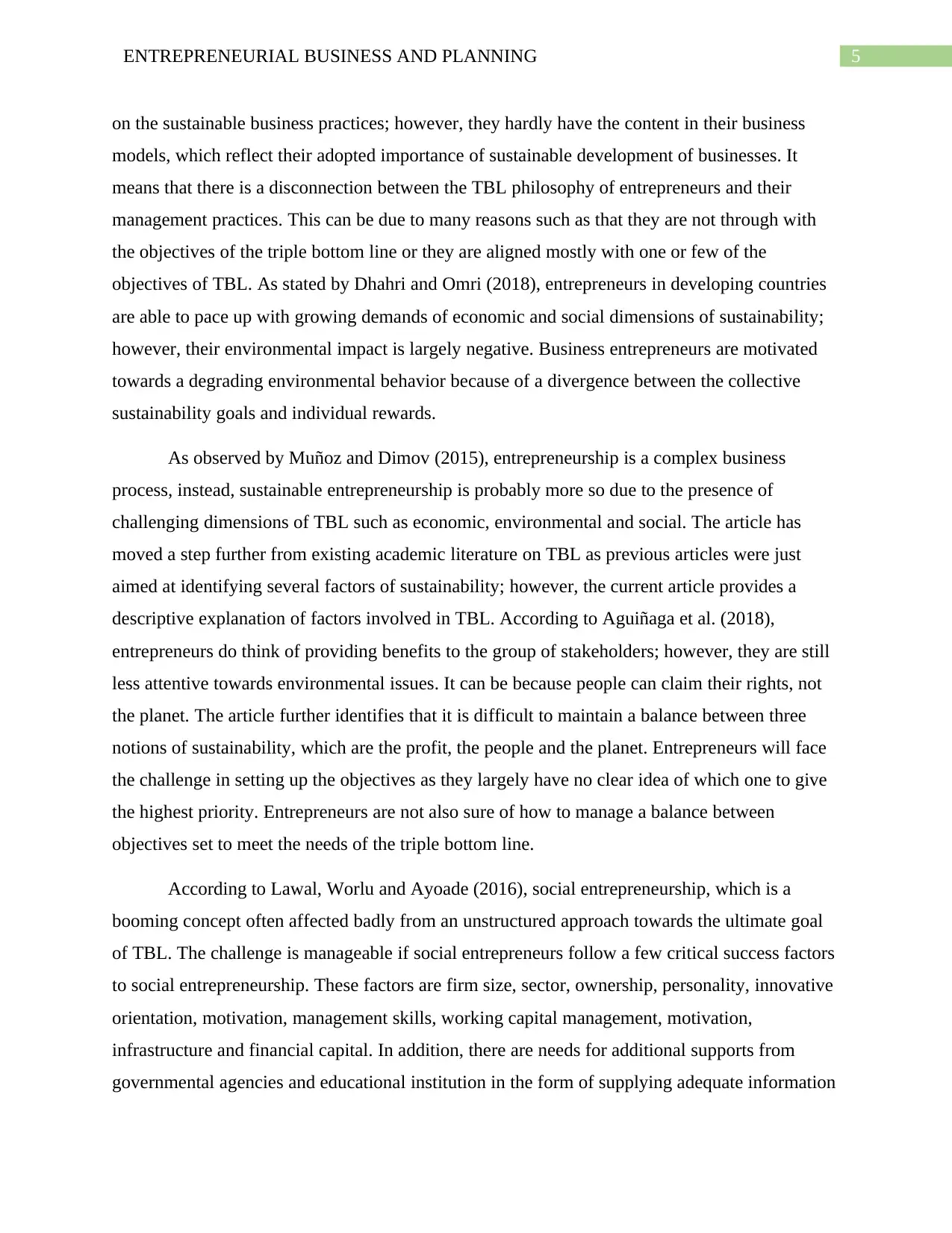
5ENTREPRENEURIAL BUSINESS AND PLANNING
on the sustainable business practices; however, they hardly have the content in their business
models, which reflect their adopted importance of sustainable development of businesses. It
means that there is a disconnection between the TBL philosophy of entrepreneurs and their
management practices. This can be due to many reasons such as that they are not through with
the objectives of the triple bottom line or they are aligned mostly with one or few of the
objectives of TBL. As stated by Dhahri and Omri (2018), entrepreneurs in developing countries
are able to pace up with growing demands of economic and social dimensions of sustainability;
however, their environmental impact is largely negative. Business entrepreneurs are motivated
towards a degrading environmental behavior because of a divergence between the collective
sustainability goals and individual rewards.
As observed by Muñoz and Dimov (2015), entrepreneurship is a complex business
process, instead, sustainable entrepreneurship is probably more so due to the presence of
challenging dimensions of TBL such as economic, environmental and social. The article has
moved a step further from existing academic literature on TBL as previous articles were just
aimed at identifying several factors of sustainability; however, the current article provides a
descriptive explanation of factors involved in TBL. According to Aguiñaga et al. (2018),
entrepreneurs do think of providing benefits to the group of stakeholders; however, they are still
less attentive towards environmental issues. It can be because people can claim their rights, not
the planet. The article further identifies that it is difficult to maintain a balance between three
notions of sustainability, which are the profit, the people and the planet. Entrepreneurs will face
the challenge in setting up the objectives as they largely have no clear idea of which one to give
the highest priority. Entrepreneurs are not also sure of how to manage a balance between
objectives set to meet the needs of the triple bottom line.
According to Lawal, Worlu and Ayoade (2016), social entrepreneurship, which is a
booming concept often affected badly from an unstructured approach towards the ultimate goal
of TBL. The challenge is manageable if social entrepreneurs follow a few critical success factors
to social entrepreneurship. These factors are firm size, sector, ownership, personality, innovative
orientation, motivation, management skills, working capital management, motivation,
infrastructure and financial capital. In addition, there are needs for additional supports from
governmental agencies and educational institution in the form of supplying adequate information
on the sustainable business practices; however, they hardly have the content in their business
models, which reflect their adopted importance of sustainable development of businesses. It
means that there is a disconnection between the TBL philosophy of entrepreneurs and their
management practices. This can be due to many reasons such as that they are not through with
the objectives of the triple bottom line or they are aligned mostly with one or few of the
objectives of TBL. As stated by Dhahri and Omri (2018), entrepreneurs in developing countries
are able to pace up with growing demands of economic and social dimensions of sustainability;
however, their environmental impact is largely negative. Business entrepreneurs are motivated
towards a degrading environmental behavior because of a divergence between the collective
sustainability goals and individual rewards.
As observed by Muñoz and Dimov (2015), entrepreneurship is a complex business
process, instead, sustainable entrepreneurship is probably more so due to the presence of
challenging dimensions of TBL such as economic, environmental and social. The article has
moved a step further from existing academic literature on TBL as previous articles were just
aimed at identifying several factors of sustainability; however, the current article provides a
descriptive explanation of factors involved in TBL. According to Aguiñaga et al. (2018),
entrepreneurs do think of providing benefits to the group of stakeholders; however, they are still
less attentive towards environmental issues. It can be because people can claim their rights, not
the planet. The article further identifies that it is difficult to maintain a balance between three
notions of sustainability, which are the profit, the people and the planet. Entrepreneurs will face
the challenge in setting up the objectives as they largely have no clear idea of which one to give
the highest priority. Entrepreneurs are not also sure of how to manage a balance between
objectives set to meet the needs of the triple bottom line.
According to Lawal, Worlu and Ayoade (2016), social entrepreneurship, which is a
booming concept often affected badly from an unstructured approach towards the ultimate goal
of TBL. The challenge is manageable if social entrepreneurs follow a few critical success factors
to social entrepreneurship. These factors are firm size, sector, ownership, personality, innovative
orientation, motivation, management skills, working capital management, motivation,
infrastructure and financial capital. In addition, there are needs for additional supports from
governmental agencies and educational institution in the form of supplying adequate information
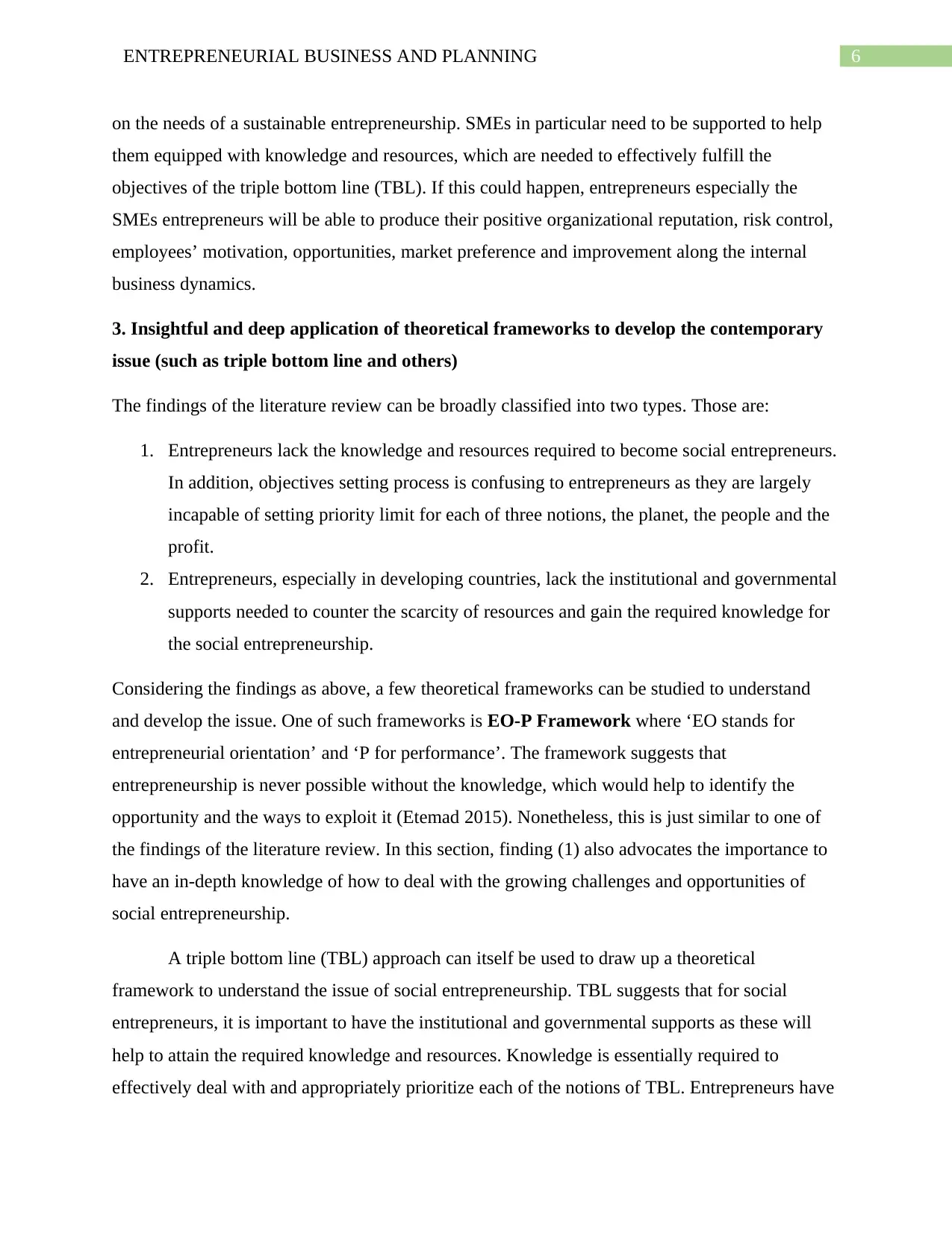
6ENTREPRENEURIAL BUSINESS AND PLANNING
on the needs of a sustainable entrepreneurship. SMEs in particular need to be supported to help
them equipped with knowledge and resources, which are needed to effectively fulfill the
objectives of the triple bottom line (TBL). If this could happen, entrepreneurs especially the
SMEs entrepreneurs will be able to produce their positive organizational reputation, risk control,
employees’ motivation, opportunities, market preference and improvement along the internal
business dynamics.
3. Insightful and deep application of theoretical frameworks to develop the contemporary
issue (such as triple bottom line and others)
The findings of the literature review can be broadly classified into two types. Those are:
1. Entrepreneurs lack the knowledge and resources required to become social entrepreneurs.
In addition, objectives setting process is confusing to entrepreneurs as they are largely
incapable of setting priority limit for each of three notions, the planet, the people and the
profit.
2. Entrepreneurs, especially in developing countries, lack the institutional and governmental
supports needed to counter the scarcity of resources and gain the required knowledge for
the social entrepreneurship.
Considering the findings as above, a few theoretical frameworks can be studied to understand
and develop the issue. One of such frameworks is EO-P Framework where ‘EO stands for
entrepreneurial orientation’ and ‘P for performance’. The framework suggests that
entrepreneurship is never possible without the knowledge, which would help to identify the
opportunity and the ways to exploit it (Etemad 2015). Nonetheless, this is just similar to one of
the findings of the literature review. In this section, finding (1) also advocates the importance to
have an in-depth knowledge of how to deal with the growing challenges and opportunities of
social entrepreneurship.
A triple bottom line (TBL) approach can itself be used to draw up a theoretical
framework to understand the issue of social entrepreneurship. TBL suggests that for social
entrepreneurs, it is important to have the institutional and governmental supports as these will
help to attain the required knowledge and resources. Knowledge is essentially required to
effectively deal with and appropriately prioritize each of the notions of TBL. Entrepreneurs have
on the needs of a sustainable entrepreneurship. SMEs in particular need to be supported to help
them equipped with knowledge and resources, which are needed to effectively fulfill the
objectives of the triple bottom line (TBL). If this could happen, entrepreneurs especially the
SMEs entrepreneurs will be able to produce their positive organizational reputation, risk control,
employees’ motivation, opportunities, market preference and improvement along the internal
business dynamics.
3. Insightful and deep application of theoretical frameworks to develop the contemporary
issue (such as triple bottom line and others)
The findings of the literature review can be broadly classified into two types. Those are:
1. Entrepreneurs lack the knowledge and resources required to become social entrepreneurs.
In addition, objectives setting process is confusing to entrepreneurs as they are largely
incapable of setting priority limit for each of three notions, the planet, the people and the
profit.
2. Entrepreneurs, especially in developing countries, lack the institutional and governmental
supports needed to counter the scarcity of resources and gain the required knowledge for
the social entrepreneurship.
Considering the findings as above, a few theoretical frameworks can be studied to understand
and develop the issue. One of such frameworks is EO-P Framework where ‘EO stands for
entrepreneurial orientation’ and ‘P for performance’. The framework suggests that
entrepreneurship is never possible without the knowledge, which would help to identify the
opportunity and the ways to exploit it (Etemad 2015). Nonetheless, this is just similar to one of
the findings of the literature review. In this section, finding (1) also advocates the importance to
have an in-depth knowledge of how to deal with the growing challenges and opportunities of
social entrepreneurship.
A triple bottom line (TBL) approach can itself be used to draw up a theoretical
framework to understand the issue of social entrepreneurship. TBL suggests that for social
entrepreneurs, it is important to have the institutional and governmental supports as these will
help to attain the required knowledge and resources. Knowledge is essentially required to
effectively deal with and appropriately prioritize each of the notions of TBL. Entrepreneurs have
Paraphrase This Document
Need a fresh take? Get an instant paraphrase of this document with our AI Paraphraser
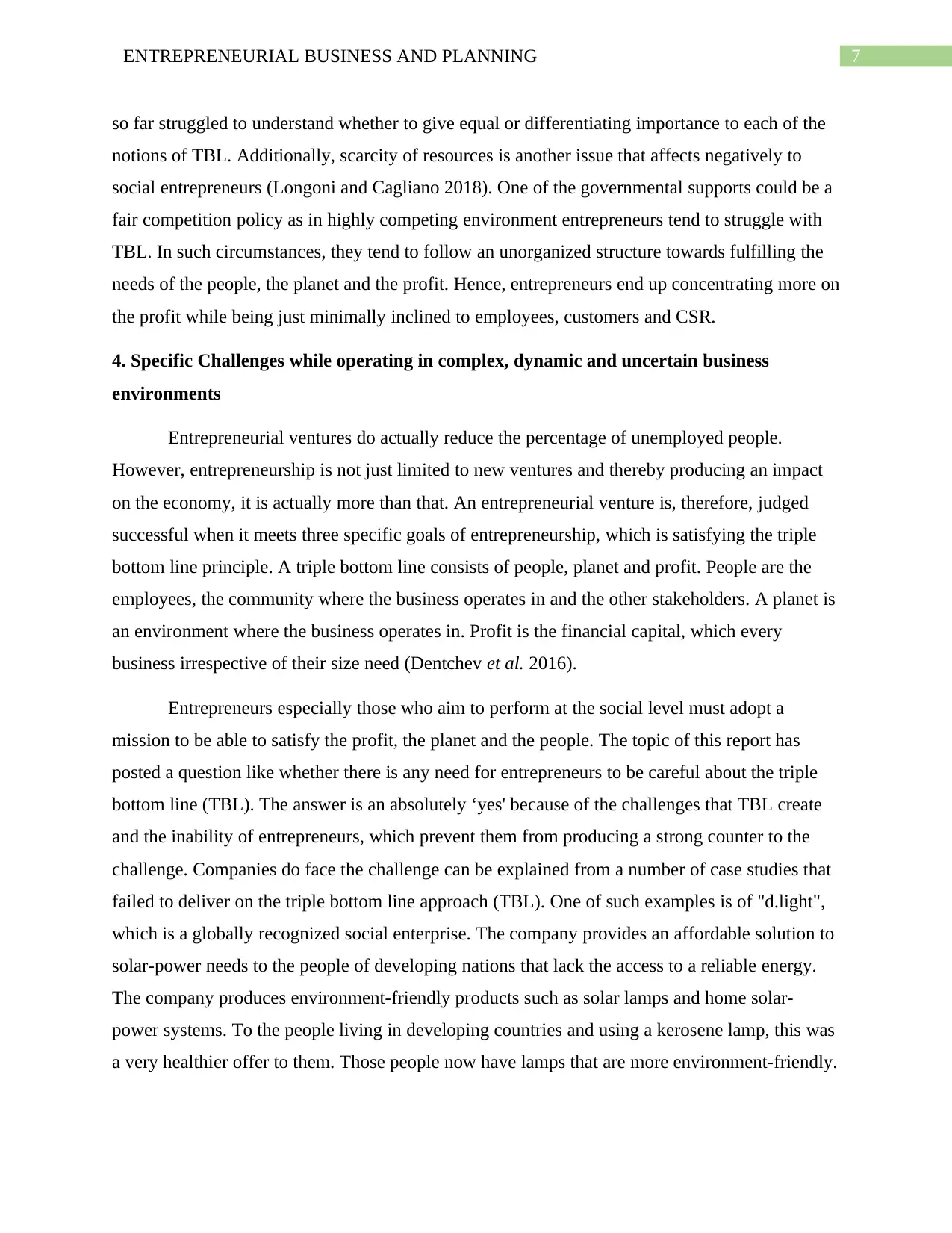
7ENTREPRENEURIAL BUSINESS AND PLANNING
so far struggled to understand whether to give equal or differentiating importance to each of the
notions of TBL. Additionally, scarcity of resources is another issue that affects negatively to
social entrepreneurs (Longoni and Cagliano 2018). One of the governmental supports could be a
fair competition policy as in highly competing environment entrepreneurs tend to struggle with
TBL. In such circumstances, they tend to follow an unorganized structure towards fulfilling the
needs of the people, the planet and the profit. Hence, entrepreneurs end up concentrating more on
the profit while being just minimally inclined to employees, customers and CSR.
4. Specific Challenges while operating in complex, dynamic and uncertain business
environments
Entrepreneurial ventures do actually reduce the percentage of unemployed people.
However, entrepreneurship is not just limited to new ventures and thereby producing an impact
on the economy, it is actually more than that. An entrepreneurial venture is, therefore, judged
successful when it meets three specific goals of entrepreneurship, which is satisfying the triple
bottom line principle. A triple bottom line consists of people, planet and profit. People are the
employees, the community where the business operates in and the other stakeholders. A planet is
an environment where the business operates in. Profit is the financial capital, which every
business irrespective of their size need (Dentchev et al. 2016).
Entrepreneurs especially those who aim to perform at the social level must adopt a
mission to be able to satisfy the profit, the planet and the people. The topic of this report has
posted a question like whether there is any need for entrepreneurs to be careful about the triple
bottom line (TBL). The answer is an absolutely ‘yes' because of the challenges that TBL create
and the inability of entrepreneurs, which prevent them from producing a strong counter to the
challenge. Companies do face the challenge can be explained from a number of case studies that
failed to deliver on the triple bottom line approach (TBL). One of such examples is of "d.light",
which is a globally recognized social enterprise. The company provides an affordable solution to
solar-power needs to the people of developing nations that lack the access to a reliable energy.
The company produces environment-friendly products such as solar lamps and home solar-
power systems. To the people living in developing countries and using a kerosene lamp, this was
a very healthier offer to them. Those people now have lamps that are more environment-friendly.
so far struggled to understand whether to give equal or differentiating importance to each of the
notions of TBL. Additionally, scarcity of resources is another issue that affects negatively to
social entrepreneurs (Longoni and Cagliano 2018). One of the governmental supports could be a
fair competition policy as in highly competing environment entrepreneurs tend to struggle with
TBL. In such circumstances, they tend to follow an unorganized structure towards fulfilling the
needs of the people, the planet and the profit. Hence, entrepreneurs end up concentrating more on
the profit while being just minimally inclined to employees, customers and CSR.
4. Specific Challenges while operating in complex, dynamic and uncertain business
environments
Entrepreneurial ventures do actually reduce the percentage of unemployed people.
However, entrepreneurship is not just limited to new ventures and thereby producing an impact
on the economy, it is actually more than that. An entrepreneurial venture is, therefore, judged
successful when it meets three specific goals of entrepreneurship, which is satisfying the triple
bottom line principle. A triple bottom line consists of people, planet and profit. People are the
employees, the community where the business operates in and the other stakeholders. A planet is
an environment where the business operates in. Profit is the financial capital, which every
business irrespective of their size need (Dentchev et al. 2016).
Entrepreneurs especially those who aim to perform at the social level must adopt a
mission to be able to satisfy the profit, the planet and the people. The topic of this report has
posted a question like whether there is any need for entrepreneurs to be careful about the triple
bottom line (TBL). The answer is an absolutely ‘yes' because of the challenges that TBL create
and the inability of entrepreneurs, which prevent them from producing a strong counter to the
challenge. Companies do face the challenge can be explained from a number of case studies that
failed to deliver on the triple bottom line approach (TBL). One of such examples is of "d.light",
which is a globally recognized social enterprise. The company provides an affordable solution to
solar-power needs to the people of developing nations that lack the access to a reliable energy.
The company produces environment-friendly products such as solar lamps and home solar-
power systems. To the people living in developing countries and using a kerosene lamp, this was
a very healthier offer to them. Those people now have lamps that are more environment-friendly.
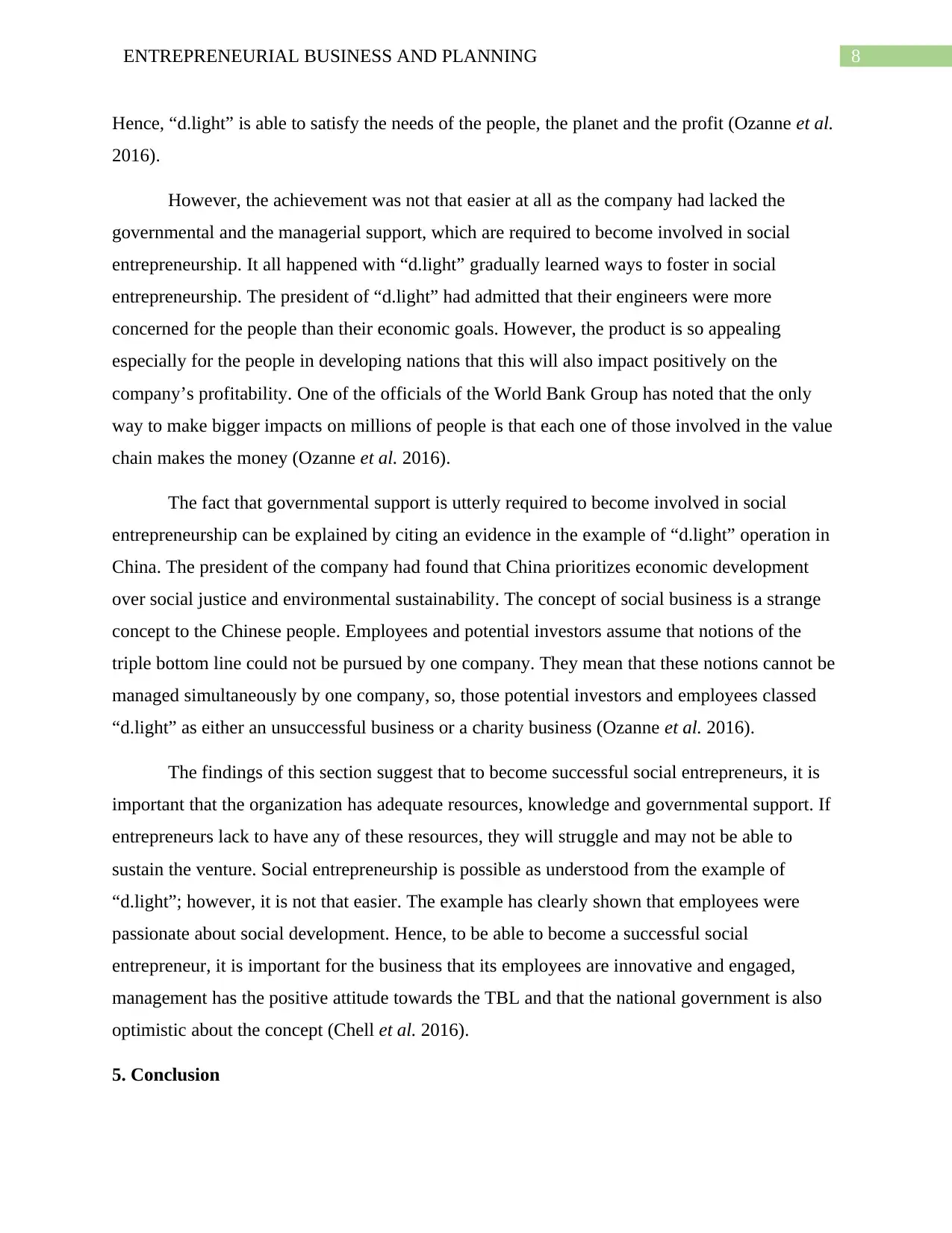
8ENTREPRENEURIAL BUSINESS AND PLANNING
Hence, “d.light” is able to satisfy the needs of the people, the planet and the profit (Ozanne et al.
2016).
However, the achievement was not that easier at all as the company had lacked the
governmental and the managerial support, which are required to become involved in social
entrepreneurship. It all happened with “d.light” gradually learned ways to foster in social
entrepreneurship. The president of “d.light” had admitted that their engineers were more
concerned for the people than their economic goals. However, the product is so appealing
especially for the people in developing nations that this will also impact positively on the
company’s profitability. One of the officials of the World Bank Group has noted that the only
way to make bigger impacts on millions of people is that each one of those involved in the value
chain makes the money (Ozanne et al. 2016).
The fact that governmental support is utterly required to become involved in social
entrepreneurship can be explained by citing an evidence in the example of “d.light” operation in
China. The president of the company had found that China prioritizes economic development
over social justice and environmental sustainability. The concept of social business is a strange
concept to the Chinese people. Employees and potential investors assume that notions of the
triple bottom line could not be pursued by one company. They mean that these notions cannot be
managed simultaneously by one company, so, those potential investors and employees classed
“d.light” as either an unsuccessful business or a charity business (Ozanne et al. 2016).
The findings of this section suggest that to become successful social entrepreneurs, it is
important that the organization has adequate resources, knowledge and governmental support. If
entrepreneurs lack to have any of these resources, they will struggle and may not be able to
sustain the venture. Social entrepreneurship is possible as understood from the example of
“d.light”; however, it is not that easier. The example has clearly shown that employees were
passionate about social development. Hence, to be able to become a successful social
entrepreneur, it is important for the business that its employees are innovative and engaged,
management has the positive attitude towards the TBL and that the national government is also
optimistic about the concept (Chell et al. 2016).
5. Conclusion
Hence, “d.light” is able to satisfy the needs of the people, the planet and the profit (Ozanne et al.
2016).
However, the achievement was not that easier at all as the company had lacked the
governmental and the managerial support, which are required to become involved in social
entrepreneurship. It all happened with “d.light” gradually learned ways to foster in social
entrepreneurship. The president of “d.light” had admitted that their engineers were more
concerned for the people than their economic goals. However, the product is so appealing
especially for the people in developing nations that this will also impact positively on the
company’s profitability. One of the officials of the World Bank Group has noted that the only
way to make bigger impacts on millions of people is that each one of those involved in the value
chain makes the money (Ozanne et al. 2016).
The fact that governmental support is utterly required to become involved in social
entrepreneurship can be explained by citing an evidence in the example of “d.light” operation in
China. The president of the company had found that China prioritizes economic development
over social justice and environmental sustainability. The concept of social business is a strange
concept to the Chinese people. Employees and potential investors assume that notions of the
triple bottom line could not be pursued by one company. They mean that these notions cannot be
managed simultaneously by one company, so, those potential investors and employees classed
“d.light” as either an unsuccessful business or a charity business (Ozanne et al. 2016).
The findings of this section suggest that to become successful social entrepreneurs, it is
important that the organization has adequate resources, knowledge and governmental support. If
entrepreneurs lack to have any of these resources, they will struggle and may not be able to
sustain the venture. Social entrepreneurship is possible as understood from the example of
“d.light”; however, it is not that easier. The example has clearly shown that employees were
passionate about social development. Hence, to be able to become a successful social
entrepreneur, it is important for the business that its employees are innovative and engaged,
management has the positive attitude towards the TBL and that the national government is also
optimistic about the concept (Chell et al. 2016).
5. Conclusion
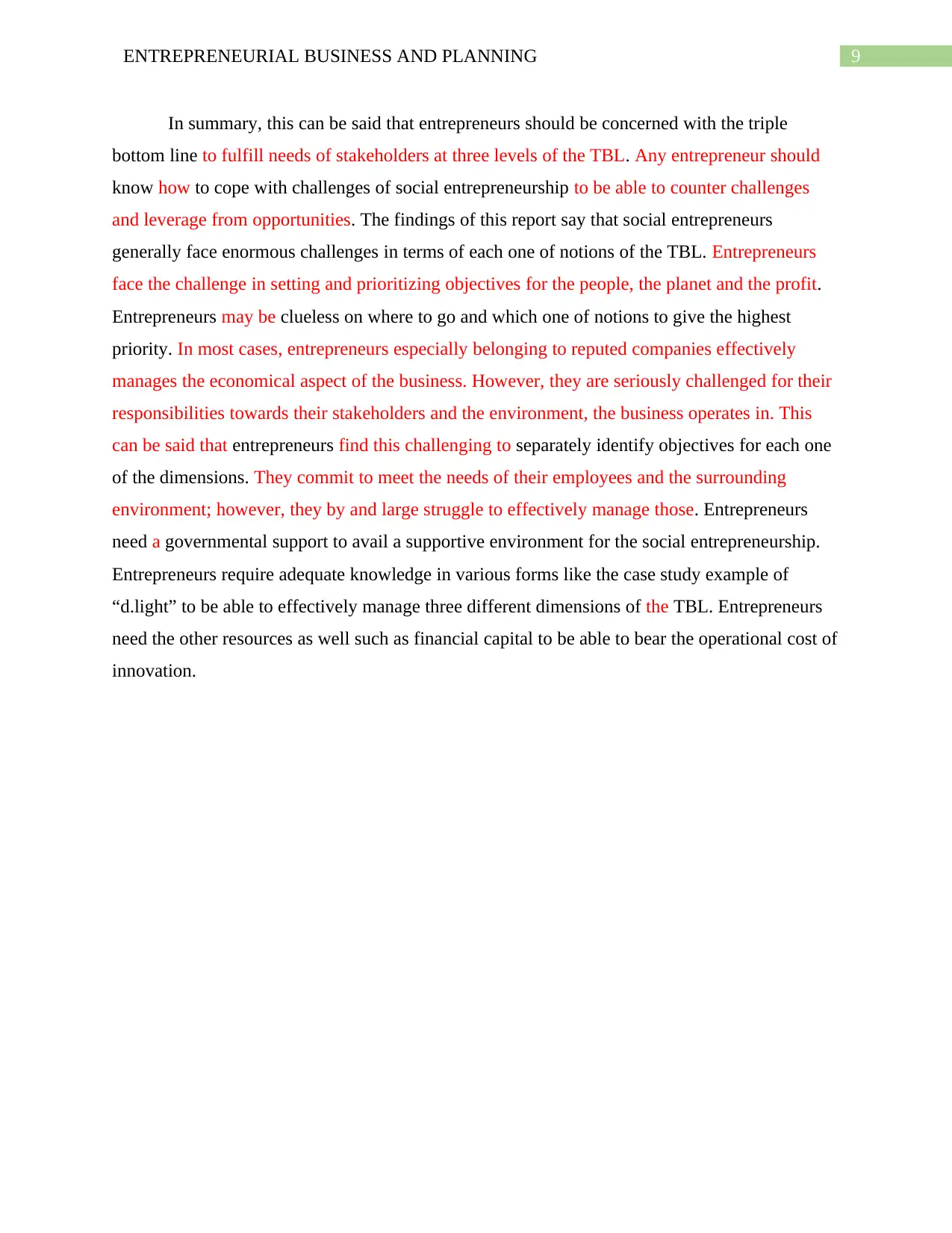
9ENTREPRENEURIAL BUSINESS AND PLANNING
In summary, this can be said that entrepreneurs should be concerned with the triple
bottom line to fulfill needs of stakeholders at three levels of the TBL. Any entrepreneur should
know how to cope with challenges of social entrepreneurship to be able to counter challenges
and leverage from opportunities. The findings of this report say that social entrepreneurs
generally face enormous challenges in terms of each one of notions of the TBL. Entrepreneurs
face the challenge in setting and prioritizing objectives for the people, the planet and the profit.
Entrepreneurs may be clueless on where to go and which one of notions to give the highest
priority. In most cases, entrepreneurs especially belonging to reputed companies effectively
manages the economical aspect of the business. However, they are seriously challenged for their
responsibilities towards their stakeholders and the environment, the business operates in. This
can be said that entrepreneurs find this challenging to separately identify objectives for each one
of the dimensions. They commit to meet the needs of their employees and the surrounding
environment; however, they by and large struggle to effectively manage those. Entrepreneurs
need a governmental support to avail a supportive environment for the social entrepreneurship.
Entrepreneurs require adequate knowledge in various forms like the case study example of
“d.light” to be able to effectively manage three different dimensions of the TBL. Entrepreneurs
need the other resources as well such as financial capital to be able to bear the operational cost of
innovation.
In summary, this can be said that entrepreneurs should be concerned with the triple
bottom line to fulfill needs of stakeholders at three levels of the TBL. Any entrepreneur should
know how to cope with challenges of social entrepreneurship to be able to counter challenges
and leverage from opportunities. The findings of this report say that social entrepreneurs
generally face enormous challenges in terms of each one of notions of the TBL. Entrepreneurs
face the challenge in setting and prioritizing objectives for the people, the planet and the profit.
Entrepreneurs may be clueless on where to go and which one of notions to give the highest
priority. In most cases, entrepreneurs especially belonging to reputed companies effectively
manages the economical aspect of the business. However, they are seriously challenged for their
responsibilities towards their stakeholders and the environment, the business operates in. This
can be said that entrepreneurs find this challenging to separately identify objectives for each one
of the dimensions. They commit to meet the needs of their employees and the surrounding
environment; however, they by and large struggle to effectively manage those. Entrepreneurs
need a governmental support to avail a supportive environment for the social entrepreneurship.
Entrepreneurs require adequate knowledge in various forms like the case study example of
“d.light” to be able to effectively manage three different dimensions of the TBL. Entrepreneurs
need the other resources as well such as financial capital to be able to bear the operational cost of
innovation.
Secure Best Marks with AI Grader
Need help grading? Try our AI Grader for instant feedback on your assignments.

10ENTREPRENEURIAL BUSINESS AND PLANNING
References
Aguiñaga, E., Henriques, I., Scheel, C. and Scheel, A., 2018. Building resilience: A self-
sustainable community approach to the triple bottom line. Journal of Cleaner Production, 173,
pp.186-196.
Chan, A.K. and Cheung, S.Y., 2015. Special issue on corporate social responsibility and
sustainability: An Introduction. Journal of Business Ethics, 130(4), pp.753-754.
Chell, E., Spence, L.J., Perrini, F. and Harris, J.D., 2016. Social entrepreneurship and business
ethics: Does social equal ethical?. Journal of business ethics, 133(4), pp.619-625.
Dentchev, N., Baumgartner, R., Dieleman, H., Jóhannsdóttir, L., Jonker, J., Nyberg, T., Rauter,
R., Rosano, M., Snihur, Y., Tang, X. and van Hoof, B., 2016. Embracing the variety of
sustainable business models: social entrepreneurship, corporate intrapreneurship, creativity,
innovation, and other approaches to sustainability challenges. Journal of Cleaner Production.
Dhahri, S. and Omri, A., 2018. Entrepreneurship contribution to the three pillars of sustainable
development: What does the evidence really say?. World Development, 106, pp.64-77.
Etemad, H., 2015. The promise of a potential theoretical framework in international
entrepreneurship: An entrepreneurial orientation-performance relation in internationalized
context. Journal of International Entrepreneurship, 13(2), pp.89-95.
Ferreira, J.J., Fernandes, C.I. and Ratten, V., 2017. Entrepreneurship, innovation and
competitiveness: what is the connection?. International Journal of Business and
Globalisation, 18(1), pp.73-95.
Galpin, T. and Hebard, J., 2015. Sustainability in start-up ventures: what founders say versus
what they do. World Journal of Entrepreneurship, Management and Sustainable
Development, 11(4), pp.246-255.
Hammer, J. and Pivo, G., 2017. The triple bottom line and sustainable economic development
theory and practice. Economic Development Quarterly, 31(1), pp.25-36.
References
Aguiñaga, E., Henriques, I., Scheel, C. and Scheel, A., 2018. Building resilience: A self-
sustainable community approach to the triple bottom line. Journal of Cleaner Production, 173,
pp.186-196.
Chan, A.K. and Cheung, S.Y., 2015. Special issue on corporate social responsibility and
sustainability: An Introduction. Journal of Business Ethics, 130(4), pp.753-754.
Chell, E., Spence, L.J., Perrini, F. and Harris, J.D., 2016. Social entrepreneurship and business
ethics: Does social equal ethical?. Journal of business ethics, 133(4), pp.619-625.
Dentchev, N., Baumgartner, R., Dieleman, H., Jóhannsdóttir, L., Jonker, J., Nyberg, T., Rauter,
R., Rosano, M., Snihur, Y., Tang, X. and van Hoof, B., 2016. Embracing the variety of
sustainable business models: social entrepreneurship, corporate intrapreneurship, creativity,
innovation, and other approaches to sustainability challenges. Journal of Cleaner Production.
Dhahri, S. and Omri, A., 2018. Entrepreneurship contribution to the three pillars of sustainable
development: What does the evidence really say?. World Development, 106, pp.64-77.
Etemad, H., 2015. The promise of a potential theoretical framework in international
entrepreneurship: An entrepreneurial orientation-performance relation in internationalized
context. Journal of International Entrepreneurship, 13(2), pp.89-95.
Ferreira, J.J., Fernandes, C.I. and Ratten, V., 2017. Entrepreneurship, innovation and
competitiveness: what is the connection?. International Journal of Business and
Globalisation, 18(1), pp.73-95.
Galpin, T. and Hebard, J., 2015. Sustainability in start-up ventures: what founders say versus
what they do. World Journal of Entrepreneurship, Management and Sustainable
Development, 11(4), pp.246-255.
Hammer, J. and Pivo, G., 2017. The triple bottom line and sustainable economic development
theory and practice. Economic Development Quarterly, 31(1), pp.25-36.
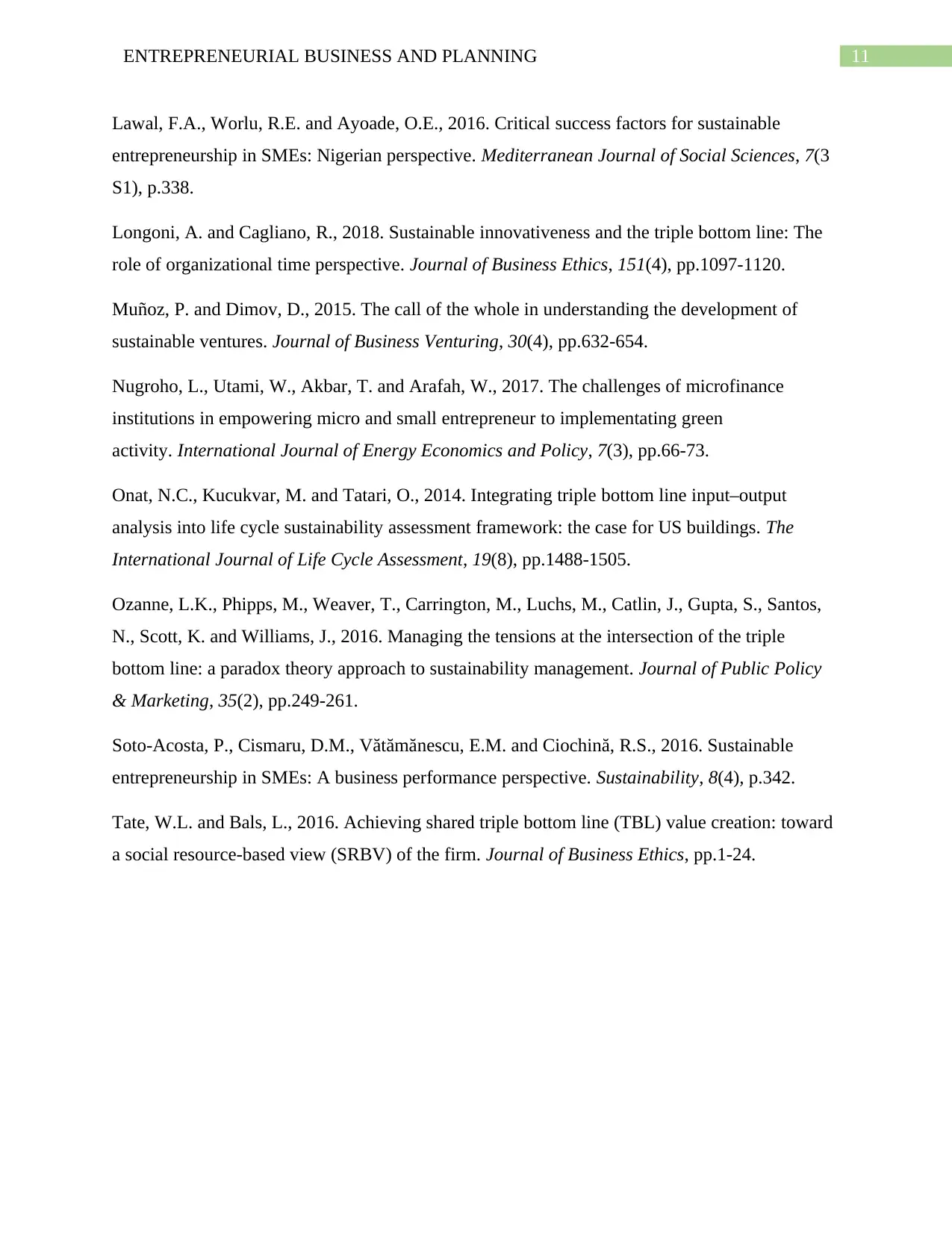
11ENTREPRENEURIAL BUSINESS AND PLANNING
Lawal, F.A., Worlu, R.E. and Ayoade, O.E., 2016. Critical success factors for sustainable
entrepreneurship in SMEs: Nigerian perspective. Mediterranean Journal of Social Sciences, 7(3
S1), p.338.
Longoni, A. and Cagliano, R., 2018. Sustainable innovativeness and the triple bottom line: The
role of organizational time perspective. Journal of Business Ethics, 151(4), pp.1097-1120.
Muñoz, P. and Dimov, D., 2015. The call of the whole in understanding the development of
sustainable ventures. Journal of Business Venturing, 30(4), pp.632-654.
Nugroho, L., Utami, W., Akbar, T. and Arafah, W., 2017. The challenges of microfinance
institutions in empowering micro and small entrepreneur to implementating green
activity. International Journal of Energy Economics and Policy, 7(3), pp.66-73.
Onat, N.C., Kucukvar, M. and Tatari, O., 2014. Integrating triple bottom line input–output
analysis into life cycle sustainability assessment framework: the case for US buildings. The
International Journal of Life Cycle Assessment, 19(8), pp.1488-1505.
Ozanne, L.K., Phipps, M., Weaver, T., Carrington, M., Luchs, M., Catlin, J., Gupta, S., Santos,
N., Scott, K. and Williams, J., 2016. Managing the tensions at the intersection of the triple
bottom line: a paradox theory approach to sustainability management. Journal of Public Policy
& Marketing, 35(2), pp.249-261.
Soto-Acosta, P., Cismaru, D.M., Vătămănescu, E.M. and Ciochină, R.S., 2016. Sustainable
entrepreneurship in SMEs: A business performance perspective. Sustainability, 8(4), p.342.
Tate, W.L. and Bals, L., 2016. Achieving shared triple bottom line (TBL) value creation: toward
a social resource-based view (SRBV) of the firm. Journal of Business Ethics, pp.1-24.
Lawal, F.A., Worlu, R.E. and Ayoade, O.E., 2016. Critical success factors for sustainable
entrepreneurship in SMEs: Nigerian perspective. Mediterranean Journal of Social Sciences, 7(3
S1), p.338.
Longoni, A. and Cagliano, R., 2018. Sustainable innovativeness and the triple bottom line: The
role of organizational time perspective. Journal of Business Ethics, 151(4), pp.1097-1120.
Muñoz, P. and Dimov, D., 2015. The call of the whole in understanding the development of
sustainable ventures. Journal of Business Venturing, 30(4), pp.632-654.
Nugroho, L., Utami, W., Akbar, T. and Arafah, W., 2017. The challenges of microfinance
institutions in empowering micro and small entrepreneur to implementating green
activity. International Journal of Energy Economics and Policy, 7(3), pp.66-73.
Onat, N.C., Kucukvar, M. and Tatari, O., 2014. Integrating triple bottom line input–output
analysis into life cycle sustainability assessment framework: the case for US buildings. The
International Journal of Life Cycle Assessment, 19(8), pp.1488-1505.
Ozanne, L.K., Phipps, M., Weaver, T., Carrington, M., Luchs, M., Catlin, J., Gupta, S., Santos,
N., Scott, K. and Williams, J., 2016. Managing the tensions at the intersection of the triple
bottom line: a paradox theory approach to sustainability management. Journal of Public Policy
& Marketing, 35(2), pp.249-261.
Soto-Acosta, P., Cismaru, D.M., Vătămănescu, E.M. and Ciochină, R.S., 2016. Sustainable
entrepreneurship in SMEs: A business performance perspective. Sustainability, 8(4), p.342.
Tate, W.L. and Bals, L., 2016. Achieving shared triple bottom line (TBL) value creation: toward
a social resource-based view (SRBV) of the firm. Journal of Business Ethics, pp.1-24.
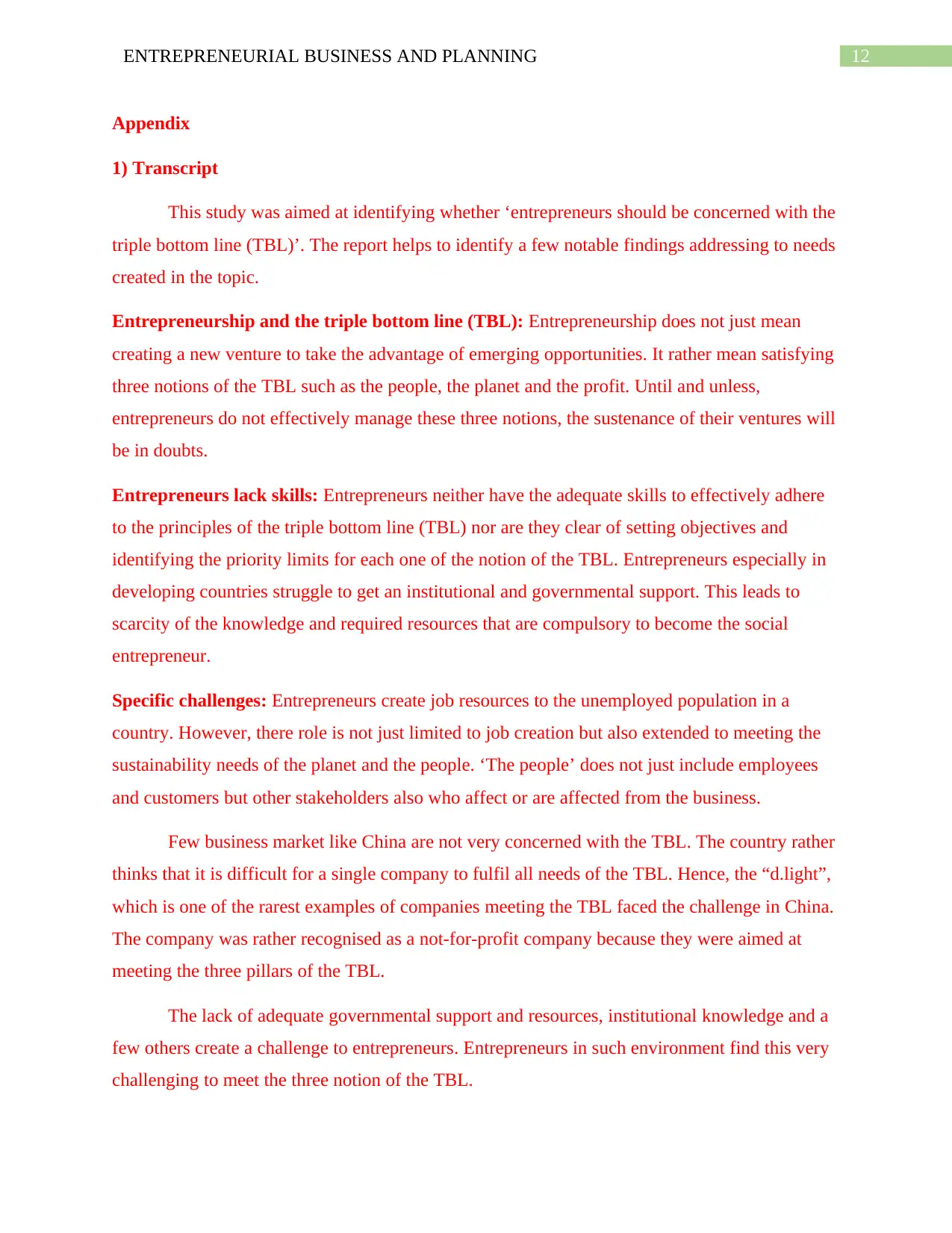
12ENTREPRENEURIAL BUSINESS AND PLANNING
Appendix
1) Transcript
This study was aimed at identifying whether ‘entrepreneurs should be concerned with the
triple bottom line (TBL)’. The report helps to identify a few notable findings addressing to needs
created in the topic.
Entrepreneurship and the triple bottom line (TBL): Entrepreneurship does not just mean
creating a new venture to take the advantage of emerging opportunities. It rather mean satisfying
three notions of the TBL such as the people, the planet and the profit. Until and unless,
entrepreneurs do not effectively manage these three notions, the sustenance of their ventures will
be in doubts.
Entrepreneurs lack skills: Entrepreneurs neither have the adequate skills to effectively adhere
to the principles of the triple bottom line (TBL) nor are they clear of setting objectives and
identifying the priority limits for each one of the notion of the TBL. Entrepreneurs especially in
developing countries struggle to get an institutional and governmental support. This leads to
scarcity of the knowledge and required resources that are compulsory to become the social
entrepreneur.
Specific challenges: Entrepreneurs create job resources to the unemployed population in a
country. However, there role is not just limited to job creation but also extended to meeting the
sustainability needs of the planet and the people. ‘The people’ does not just include employees
and customers but other stakeholders also who affect or are affected from the business.
Few business market like China are not very concerned with the TBL. The country rather
thinks that it is difficult for a single company to fulfil all needs of the TBL. Hence, the “d.light”,
which is one of the rarest examples of companies meeting the TBL faced the challenge in China.
The company was rather recognised as a not-for-profit company because they were aimed at
meeting the three pillars of the TBL.
The lack of adequate governmental support and resources, institutional knowledge and a
few others create a challenge to entrepreneurs. Entrepreneurs in such environment find this very
challenging to meet the three notion of the TBL.
Appendix
1) Transcript
This study was aimed at identifying whether ‘entrepreneurs should be concerned with the
triple bottom line (TBL)’. The report helps to identify a few notable findings addressing to needs
created in the topic.
Entrepreneurship and the triple bottom line (TBL): Entrepreneurship does not just mean
creating a new venture to take the advantage of emerging opportunities. It rather mean satisfying
three notions of the TBL such as the people, the planet and the profit. Until and unless,
entrepreneurs do not effectively manage these three notions, the sustenance of their ventures will
be in doubts.
Entrepreneurs lack skills: Entrepreneurs neither have the adequate skills to effectively adhere
to the principles of the triple bottom line (TBL) nor are they clear of setting objectives and
identifying the priority limits for each one of the notion of the TBL. Entrepreneurs especially in
developing countries struggle to get an institutional and governmental support. This leads to
scarcity of the knowledge and required resources that are compulsory to become the social
entrepreneur.
Specific challenges: Entrepreneurs create job resources to the unemployed population in a
country. However, there role is not just limited to job creation but also extended to meeting the
sustainability needs of the planet and the people. ‘The people’ does not just include employees
and customers but other stakeholders also who affect or are affected from the business.
Few business market like China are not very concerned with the TBL. The country rather
thinks that it is difficult for a single company to fulfil all needs of the TBL. Hence, the “d.light”,
which is one of the rarest examples of companies meeting the TBL faced the challenge in China.
The company was rather recognised as a not-for-profit company because they were aimed at
meeting the three pillars of the TBL.
The lack of adequate governmental support and resources, institutional knowledge and a
few others create a challenge to entrepreneurs. Entrepreneurs in such environment find this very
challenging to meet the three notion of the TBL.
Paraphrase This Document
Need a fresh take? Get an instant paraphrase of this document with our AI Paraphraser

13ENTREPRENEURIAL BUSINESS AND PLANNING
2) Video link
Pursuit of a Triple Bottom Line: People, Planet and Profits available at:
https://www.youtube.com/watch?v=r2-M4ZhBJe0
2) Video link
Pursuit of a Triple Bottom Line: People, Planet and Profits available at:
https://www.youtube.com/watch?v=r2-M4ZhBJe0
1 out of 14
Your All-in-One AI-Powered Toolkit for Academic Success.
+13062052269
info@desklib.com
Available 24*7 on WhatsApp / Email
![[object Object]](/_next/static/media/star-bottom.7253800d.svg)
Unlock your academic potential
© 2024 | Zucol Services PVT LTD | All rights reserved.